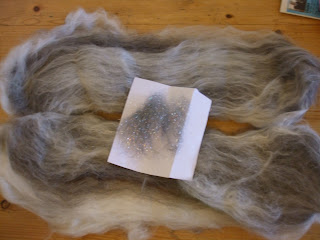(for more details or to book a place please e-mail me - deborah.gray7@btinternet.com )
For a discount on workshops, look at the Special Offer with the Fleece On the Hoof Day
March 17th (Saturday) 1 - 4pm Drop-spindle spinning £36
Elena Costella's Yarn and Fibre Studio, Bridgend, Perth
Just what it says on the tin, 3 hours of drop-spindle spinning. Suitable for beginners or improvers. I will provide spindles and prepared fibre.
April 21st (Saturday) 10 - 4pm Fibre preparation and Drop-spindle spinning £70
Blackford Village Hall, Perthshire (just off the A9 halfway between Stirling and Perth)
Starting with a whole fleece, we will learn how to sort the wool, recognising the different qualities of fibre. We will then cover hand carding and combing, and learn the difference between woollen and worsted yarns. We will also look at other fibres that are available to handspinners. After a short break for lunch (not included) we will spend the afternoon using drop spindles to spin and then ply. Suitable for beginners or improvers. All equipment and materials provided.
April 22nd (Sunday) 10 - 4 Spinning with spinning wheels £70
Blackford Village Hall, Perthshire (just off the A9 halfway between Stirling and Perth)
This workshop is ideal for those who want to transfer their drop-spindle skills to a spinning wheel or who just want to improve their spinning wheel skills. We will spin singles yarns, and then learn why and how to ply the yarn, and how to 'finish' it. There will be a short break for lunch (not provided). Equipment and materials provided - £10 discount if you bring your own spinning wheel.
May 19th (Saturday) 10 - 4 Spin control £70
Blackford Village Hall, Perthshire (just off the A9 halfway between Stirling and Perth)
This workshop is for people who have some experience of spinning, whether with drop spindle or spinning wheel. We will spin a variety of yarns, learning how to control thickness and twist to produce a balanced 2-ply yarn suitable for whatever project you have in mind. We will also explore some more unusual plying techniques that give different effects. There will be a short break for lunch (not provided). Equipment and materials provided - £10 discount if you bring your own spinning wheel.
May 20th (Sunday) 10 - 4 Playing with colour £80
Blackford Village Hall, Perthshire (just off the A9 halfway between Stirling and Perth)
In this workshop we will be exploring different ways of blending colours - and fibres - to bring even more richness to handspun yarns. Subtle blends, colour gradients or wild and vibrant mixes - its up to you!! Please bring one or two shoe boxes (or similar) to take away your blended fibres. I will bring some drop-spindles in case you just can't wait to spin your blends, but if you want to use a spinning wheel please bring your own. There will be a short break for lunch (not provided). Equipment and materials provided - £10 discount if you bring your own drum carder.
May 26th & 27th The Wool School, Miagliano, Italy
Content of this weekend will be developed according to the wishes of the participants; there will probably be one day for beginners and one for improvers. Contact me for more details
I'm still hoping to confirm dates for Grantown-on-Spey and County Wicklow, Ireland - watch this space
10th June (Sunday) Fleece on the Hoof £10
Culdees Farm, Muthill, Perthshire
a great chance to select your fleece ‘on the hoof’, learn about how it was produced and then spin completely traceable local wool
After an informal (an optional) morning spin-together and bring-your-own picnic lunch we will have the opportunity to choose our fleeces - while they are still on the sheep!!
The Culdees flock are Texel cross sheep, they have a good medium staple length wool, fine springy fibres and little or no kemp. There is a significant proportion of Blue-Faced Leicester in the breeding and some of the fleeces definitely take after their grandad, having the long, fine, ringleted staples of BFL.
. The young sheep with the best wool (nearly all white gimmers this year) will be gathered for us to choose from. Each sheep has an ear tag with a number, and when you have chosen your fleece, the tag number will be noted beside your name. The sheep will be shorn over the next few days and when you return to collect your fleece it will be labeled with your name. If necessary we can arrange to post fleeces but this will incur an extra charge.
Your £10 payment includes your first fleece; once everone has chosen a fleece if there are any left you can choose more for £7 each.
NB all proceeds from this event will go to the farmer, but places should be booked through me. PLACES ARE LIMITED SO PLEASE BOOK EARLY - YOUR PLACE WILL BE CONFIRMED ONCE YOU HAVE PAID
Special Offer!! if you hold on to half of your Fleece on the Hoof ticket, you can claim a £10 discount off the cost of one of my spinning workshops or a 3 hour session of 1-1 tuition (this offer is valid between 1st March and 31st August 2012 but excludes the workshop at Elena Costella) – and that is the cost of your fleece!





























